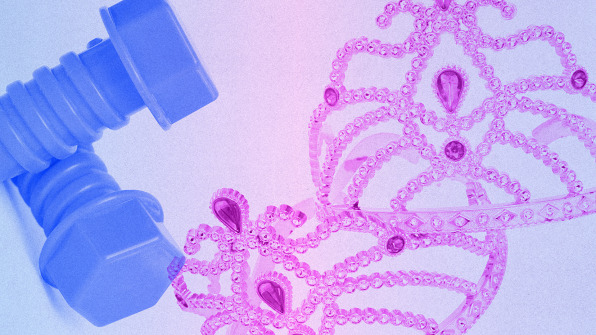Lets Go Play Friend Kids Clip Art Black and White
For better or worse, products and the designed world are used as tools for self-determination. In childhood, toys go part of a playful procedure of becoming ones' cocky. Child psychologists accept known for decades that through play, children learn empathy, "try on" identities, and experiment with their place in the earth. Substantially, in babyhood we play our way through discovering who we are. Unfortunately for kids today, the designed globe doesn't leave much room for them to explore. Near toys come with pre-defined identities and stories, which rob children of the joy of imagining these things. There is also a dearth of open up-ended toys, or toys without instructions and correct and wrong answers. This leaves few opportunities to figure out how to use a toy, experiment, fail, and invent the story of where it came from, and why it does what it does.
Imagining, understanding, and becoming who nosotros are is a process informed by play, and both toy companies and designers are taking all the exploration out of it.

Let kids imagine the story and design their own play.
The ideal toy for a child is not a toy at all but something that they've appropriated for play. Enter: sticks and rocks! Imagination transforms a stick into a magic wand, a sword, or a tool to poke a dead thing. A rock becomes a car or a whale. Because these institute objects accept no assigned story (they are "un-designed"), they shift identities as needed.
Later, the stone that was one time a automobile becomes a tool to smash leaves when the play changes. This isn't likely to happen with a toy car that has four wheels and a plastic body. That car can only be a car. The stick that was previously imagined to be a sword and helped slay a dragon (a tree) will shift to become a superhero flying through the air with jet-shoes. This can't happen with a pre-defined activeness effigy. Superheroes have specific physical characteristics which, forth with the movie, comic book or Goggle box show plot, provides the story of how that toy volition behave. In play these are the equivalent of instructions, limiting the potential for the child to invent the narrative.
I've spent fourth dimension with Penny Wilson, an influential playworker in adventure playgrounds in the U.1000., observing children playing. She taught me the important difference betwixt asking kids "What are y'all building?" and saying to them, "Tell me about what y'all're doing." When nosotros ask, 'What are you building?' it implies that: a) You should take a goal and be working toward a finished thing, i.due east., play is linear; b) y'all are supposed to be building something (children'south agreement of the built world is often limited to houses, then they are confronted with either having done it wrong, or they change their vision to fit their perception of your expectation); c) yous should be doing something that you tin can explain to me.
We desire to avoid all of these rules. So by saying "tell me virtually this" we go out the door open to stories about what children are imagining, and they can share challenges, discoveries near putting things together, or any number of things about their experience with their peers and school.
This elementary semantic shift has influenced how I pattern for play. Giving children less leaves room for them to contribute more. By allowing them to directly their own play they develop habits of agency, independence, and self-determination. Armed with these skills, they bound in to figure out who they are and will exist in the world, rather than waiting for someone to hand them a model to follow. And in today'southward toy market, the models are driven by gender.

.
Exist enlightened that gender is socialized and reinforced by toys.
Practice we really need to have a pink version and a blue version of the same toy? In most cases, the not-pink toy is the original version, and the pink is the "girl" version. Calling something a daughter toy implies the rest are for boys. In the concurrently, in that location are gross assumptions being made and socialized norms beingness formed about what girls and boys want to play with. When we tell children which toys they should like, we are telling them who they should be. Some girls like climbing trees and building. Some boys like princesses. They demand to play those roles without feeling similar they are doing something wrong.
Parents tell me "merely my girl likes pink princesses." Possibly she intrinsically does. And maybe she was built-in into a pinkish blanket and spent her infant years surrounded by pink things and at every turn she's shown princesses as the platonic girl. Maybe she doesn't know that she has other options.
This isn't an argument against pink toys. On the contrary, I believe they resonate with some girls–AND some boys. Simply as hammers should be given to girls, princesses should be offered to boys. The problem is the assumption that at that place needs to exist a "daughter version" of a toy in guild to describe her in.
In the same fashion that some girls like to build things, climb trees, and poke dead things, some boys want to play house, wear pink, and avoid mud. Boys should be encouraged to clothing pinkish tutus. Girls should exist encouraged to use hammers. Performing gender, grade, race, and careers is the beginning of learning empathy. More specifically, through open-ended play they take the agency to understand their identity as their own to invent and define.
When children have agency in their play, they acquire to have agency in their lives. The instructions we should give to children? Don't look for someone to tell you lot who and what to exist–jump in and figure it out.
Source: https://www.fastcompany.com/3048508/the-case-for-letting-kids-design-their-own-play
Post a Comment for "Lets Go Play Friend Kids Clip Art Black and White"